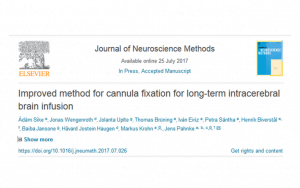 “Improved method for cannula fixation for long-term intracerebral brain infusion” has been published in the Journal of Neuroscience Methods. This work was supported in part by JPND through the NeuroGEM project, selected in the 2013 cross-disease analysis call, and the PROP-AD project, selected in the 2015 JPco-fuND call.
“Improved method for cannula fixation for long-term intracerebral brain infusion” has been published in the Journal of Neuroscience Methods. This work was supported in part by JPND through the NeuroGEM project, selected in the 2013 cross-disease analysis call, and the PROP-AD project, selected in the 2015 JPco-fuND call.
Monthly Archives: juli 2017
By studying cells from patients with motor neuron disease, also known as amyotrophic lateral sclerosis (ALS), researchers have revealed a detailed picture of how motor neurons — nerve cells in the brain and spinal cord that control our muscles and allow us to move, talk and breathe — decline and die.
The research, published in Cell Reports, also shows that healthy neuron-supporting cells called astrocytes may play a role in the survival of motor neurons in this type of ALS, highlighting their potential role in combating neurodegenerative diseases.
The team took skin cells from healthy volunteers and patients with a genetic mutation that causes ALS, and turned them into stem cells capable of becoming many other cell types. Using specific chemical signals, they then ‘guided’ the stem cells into becoming motor neurons and astrocytes.
Using a range of cellular and molecular techniques, the team tracked motor neurons over time to see what went wrong in the patient-derived cells compared to those from healthy people. They found that an important protein known as TDP-43 leaks out of the nucleus where it belongs, causing a chain reaction that damaged several crucial parts of the cell’s ‘machinery’. Defining the sequence of molecular events that led to motor neuron death in an experiment using human-derived cells is an important step forward.
The team suspected that astrocytes from the patients’ cells might also be affected, becoming less efficient over time and eventually dying. To test this, they mixed different combinations of healthy and ALS patient-derived motor neurons and astrocytes, and followed their fate using highly sensitive imaging approaches. They found that healthy astrocytes kept sick motor neurons alive and functioning for longer, but sick astrocytes struggled to keep even healthy motor neurons alive.
Paper: “Progressive motor neuron pathology and the role of astrocytes in a human stem cell model of VCP-related ALS”
Reprinted from materials provided by the Francis Crick Institute.
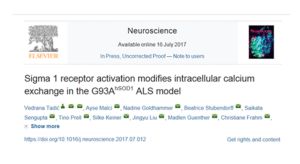 “Sigma 1 receptor activation modifies intracellular calcium exchange in the G93AhSOD1 ALS model” has been published in the journal Neuroscience. This work was supported in part by JPND through the SOPHIA project, selected in the 2011 Biomarkers call.
“Sigma 1 receptor activation modifies intracellular calcium exchange in the G93AhSOD1 ALS model” has been published in the journal Neuroscience. This work was supported in part by JPND through the SOPHIA project, selected in the 2011 Biomarkers call.
By using induced pluripotent stem cells to create endothelial cells that line blood vessels in the brain for the first time for a neurodegenerative disease, researchers have learned why Huntington’s disease patients have defects in the blood-brain barrier that contribute to the symptoms of this fatal disorder. The study, which is the first induced pluripotent stem cell-based model of the blood-brain barrier for a neurodegenerative disease, was published in Cell Reports.
The blood-brain barrier protects the brain from harmful molecules and proteins. It has been established that in Huntington’s and other neurodegenerative diseases there are defects in this barrier adding to HD symptoms. What was not known was whether these defects come from the cells that constitute the barrier or are secondary effects from other brain cells.
To answer that question, researchers reprogrammed cells from HD patients into induced pluripotent stem cells, then differentiated them into brain microvascular endothelial cells — those that form the internal lining of blood vessels and prevent leakage of blood proteins and immune cells.
The researchers discovered that blood vessels in the brains of HD patients become abnormal due to the presence of the mutated Huntingtin protein, the hallmark molecule linked to the disease. As a result, these blood vessels have a diminished capacity to form new blood vessels and are leaky compared to those derived from control patients.
The chronic production of the mutant Huntingtin protein in the blood vessel cells causes other genes within the cells to be abnormally expressed, which in turn disrupts their normal functions, such as creating new vessels, maintaining an appropriate barrier to outside molecules, and eliminating harmful substances that may enter the brain.
In addition, by conducting in-depth analyses of the altered gene expression patterns in these cells, the researchers identified a key signaling pathway known as the Wnt that helps explain why these defects occur. In the healthy brain, this pathway plays an important role in forming and preserving the blood-brain barrier. The researchers showed that most of the defects in HD patients’ blood vessels can be prevented when the vessels are exposed to a compound (XAV939) that inhibits the activity of the Wnt pathway.
Paper: “Huntington’s Disease iPSC-Derived Brain Microvascular Endothelial Cells Reveal WNT-Mediated Angiogenic and Blood-Brain Barrier Deficits”
Reprinted from materials provided by the University of California, Irvine.
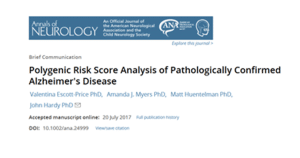 “Polygenic Risk Score Analysis of Pathologically Confirmed Alzheimer’s Disease” has been published in the journal Annals of Neurology. This work was supported in part by JPND through the PERADES project, selected in the 2012 Risk Factors call.
“Polygenic Risk Score Analysis of Pathologically Confirmed Alzheimer’s Disease” has been published in the journal Annals of Neurology. This work was supported in part by JPND through the PERADES project, selected in the 2012 Risk Factors call.
Many diseases, including Parkinson’s disease, can be treated with electrical stimulation from an electrode implanted in the brain. However, the electrodes can produce scarring, which diminishes their effectiveness and can necessitate additional surgeries to replace them.
Now, in a study published in Scientific Reports, researchers have demonstrated that making these electrodes much smaller can essentially eliminate this scarring, potentially allowing the devices to remain in the brain for much longer.
Many Parkinson’s patients have benefited from treatment with low-frequency electrical current delivered to a part of the brain involved in movement control. The electrodes used for this deep brain stimulation are a few millimeters in diameter. After being implanted, they gradually generate scar tissue through the constant rubbing of the electrode against the surrounding brain tissue. This process, known as gliosis, contributes to the high failure rate of such devices: About half stop working within the first six months.
Previous studies have suggested that making the implants smaller or softer could reduce the amount of scarring, so the research team set out to measure the effects of both reducing the size of the implants and coating them with a soft polyethylene glycol (PEG) hydrogel.
In mice, the researchers tested both coated and uncoated glass fibers with varying diameters and found that there is a tradeoff between size and softness. Coated fibers produced much less scarring than uncoated fibers of the same diameter. However, as the electrode fibers became smaller, down to about 30 microns (0.03 millimeters) in diameter, the uncoated versions produced less scarring, because the coatings increase the diameter. This suggests that a 30-micron, uncoated fiber is the optimal design for implantable devices in the brain.
The question now is whether fibers that are only 30 microns in diameter can be adapted for electrical stimulation, drug delivery, and recording electrical activity in the brain. Such devices could be potentially useful for treating Parkinson’s disease or other neurological disorders, the researchers say.
Paper: “Making brain implants smaller could prolong their lifespan: Thin fibers could be used to deliver drugs or electrical stimulation, with less damage to the brain.”
Reprinted from materials provided by the Massachusetts Institute of Technology.
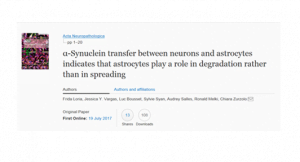 “α-Synuclein transfer between neurons and astrocytes indicates that astrocytes play a role in degradation rather than in spreading” has been published in Acta Neuropathologica. This work was supported in part by JPND through the NeuTARGETS project, selected in the 2013 Cross-Disease Analysis call.
“α-Synuclein transfer between neurons and astrocytes indicates that astrocytes play a role in degradation rather than in spreading” has been published in Acta Neuropathologica. This work was supported in part by JPND through the NeuTARGETS project, selected in the 2013 Cross-Disease Analysis call.
In a new study published in Molecular Psychiatry, researchers have measured how deposits of the pathological protein tau spread through the brain over the course of Alzheimer’s disease. Their results show that the size of the deposit and the speed of its spread differ from one individual to the next, and that large amounts of tau in the brain can be linked to episodic memory impairment.
Even in a very early phase of Alzheimer’s disease there is an accumulation of tau in the brain cells, where its adverse effect on cell function causes memory impairment. It is therefore an attractive target for vaccine researchers. For the present study, the research team used PET brain imaging to measure the spread of tau deposits as well as the amyloid plaque associated with Alzheimer’s disease, and charted the energy metabolism of the brain cells. They then examined how these three parameters changed over the course of the disease.
The study included 16 patients at different stages of Alzheimer’s disease. The patients were given a series of neurological memory tests and underwent PET scans at 17-month intervals. While all 16 participants had abundant amyloid plaque deposition in the brain, the size and speed of spread of their tau deposits differed significantly between individuals. A notable correlation between the size of the deposit and episodic memory impairment was also found, the researchers said, noting that this could explain differences in disease progression across patients.
Paper: “Longitudinal changes of tau PET imaging in relation to hypometabolism in prodromal and Alzheimer’s disease dementia”
Reprinted from materials provided by Karolinska Institutet.
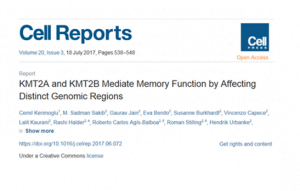 “KMT2A and KMT2B Mediate Memory Function by Affecting Distinct Genomic Regions” has been published in Cell Reports. This work was supported in part by JPND through the RiMod-FTD project, selected in the 2012 Risk Factors call.
“KMT2A and KMT2B Mediate Memory Function by Affecting Distinct Genomic Regions” has been published in Cell Reports. This work was supported in part by JPND through the RiMod-FTD project, selected in the 2012 Risk Factors call.
A new article published in JAMA Neurology compares survival rates among patients with synucleinopathies, including Parkinson’s disease, dementia with Lewy bodies, Parkinson’s disease dementia and multiple system atrophy with parkinsonism, with individuals in the general population.
The population-based study included all the residents of Minnesota’s Olmsted County and identified 461 patients with synucleinopathies and 452 patients without for comparison.
From 1991 through 2010, the 461 patients with a synucleinopathy diagnosis included 309 with Parkinson’s disease, 81 with dementia with Lewy bodies, 55 with Parkinson’s disease dementia and 16 with multiple system atrophy with parkinsonism. Parkinsonism was defined as the presence of at least 2 of 4 cardinal signs: rest tremor, bradykinesia, rigidity and impaired postural reflexes.
Of the 461 patients with synucleinopathies, 316 (68.6 percent) died during follow-up, while among the 452 participants used for comparison, 220 (48.7 percent) died during follow-up.
Overall, patients with synucleinopathies died about two years earlier than participants without in the comparison group. The highest risk of death was seen among patients with multiple system atrophy with parkinsonism, followed by patients with dementia with Lewy bodies, Parkinson’s disease dementia and Parkinson’s disease, according to the results.
Paper: “Survival and Causes of Death Among People With Clinically Diagnosed Synucleinopathies With Parkinsonism”
Reprinted from materials provided by The JAMA Network.
